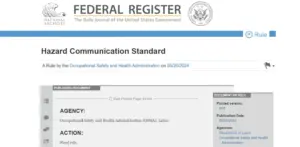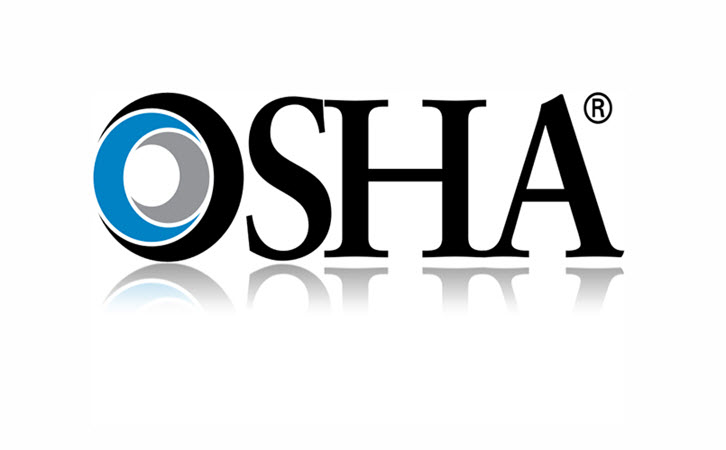By Phil Molé, MPH
It’s finally happened! OSHA has published its long-awaited final rule updating requirements in its Hazard Communication (HazCom) Standard. The publication of the final rule ends months of waiting and uncertainty by manufacturers and users of hazardous chemicals and aligns HazCom with updated versions of the UN’s Globally Harmonized System of Classification and Labelling of Chemicals (GHS), mostly Revision 7, but with inclusion of select elements of Revision 8.
It’s taken a while. OSHA first published a Notice of Proposed Rulemaking (NPRM) indicating planned updates to HazCom in February 2021 and received so much feedback during the public comment period that they held a public hearing in September 2022 to get additional stakeholder input. Federal agency regulatory agendas had shown that OSHA had passed at least two projected due dates for publication of the final rule, with the most recent expected arrival date of late 2023; now months behind in the rear-view mirror.
It’s safe to assume that the long gestation period for the final rule was a result of the large amount of stakeholder feedback OSHA received, as well as the volume of updated text and charts OSHA needed to develop to realize their planned changes. Review by the Office of Management and Budget, a necessary step prior to publication of any final regulation in the US, also took longer than usual. Now it’s easy to understand why— the pre-publication version of the final rule was over 700 pages long, and it takes up over 300 formatted pages in the Federal Register. But the rule is here now, and the compliance timeline for users of hazardous chemicals has officially begun.

At a high level, the changes brought by the OSHA final rule revising the HazCom Standard include:
- Revised classification criteria for certain chemical products, namely aerosols, desensitized explosives and flammable gases, to better capture and communicate their hazards to downstream users. OSHA has also adopted a new hazard category, Chemicals Under Pressure, within the aerosols class following classification criteria in GHS Revision 8. These revised classifications also change some of the associated hazard information, including hazard pictograms and hazard and precautionary statements.
- Revised provisions for labels, including provisions addressing the labeling of small containers. The final rule incorporates guidance previously provided by OSHA for labeling “small containers” into the text of Standard itself, defining a small container as 100 mL or less in volume, and lets chemical manufacturers use an abbreviated version of shipped container label information for small containers. The final rule also allows chemical manufacturers, distributors, or importers to provide only a product identifier on “very small containers” (3 ml or less) if they can demonstrate that a label would interfere with the normal use of the container, although they’d still need to include the full shipped container label information on the outer packaging. Also, the final rule states that manufacturers, distributors, or importers that become aware of new significant hazard information would not need to relabel chemical products already released for shipment. Interestingly, OSHA is not requiring a “released for shipment” date on the label as the NPRM had proposed, citing stakeholder arguments about unfeasibility as the reason for the change.
- Amendments related to criteria for information to consider when classifying a chemical, and its associated effects on information to include in Section 2 of a product’s safety data sheet (SDS). The NPRM had proposed that manufacturers consider classification based on “normal conditions of use and foreseeable emergencies” and inclusion of that information in Section 2. Many chemical manufacturers had pushed back on that, arguing that the requirement was too open-ended and that they were too far upstream of a chemical’s uses to be able to anticipate all reactions or chemical changes that could result from different use cases. The final rule attempts to delineate responsibilities further, stating that “hazard classification must include hazards associated with the chemical’s intrinsic properties including: (i) a change in the chemical’s physical form and; (ii) chemical reaction products associated with known or reasonably anticipated uses or applications.” The final rule clarifies that hazards from a chemical reaction (the actual GHS-based classifications) belong in Section 2(c) of the SDS, and hazards from changes in intrinsic and physical form belong in 2(a).
- Other updates to information requirements for SDSs, including addition of “particle characteristics” for solid products in Section 9 of SDSs. The final rule notes that this requirement only applies when such particle information, such as median and range of particle size, is readily available, and that the Standard does not require chemical manufacturers to conduct testing to determine particle characteristics.
- New provisions relating to how chemical manufacturers can choose to use concentration ranges of chemicals to claim trade secrets.
OSHA has extended the timeline for compliance with the final rule, compared with the timeline originally proposed in the NPRM. The proposed timeline had been 1 year for manufacturers of substances and 2 years for manufacturers of mixtures. Based on stakeholder feedback, OSHA has lengthened the timeline in the final rule to 18 months for manufacturers of substances and 36 months for manufacturers of mixtures, as measured from the effective date of the final rule of July 19, 2024.
OSHA has also established a summary page on its recent HazCom changes, including the final rule, that they may continue updating with additional final rule details.
The new HazCom final rule will not have the same level of impact as the 2012 final rule that first aligned HazCom with the GHS. The current changes are more limited in scope, affecting a handful of chemical hazard classes, and specific details related to chemical classification and information on SDSs. Even so, many manufacturers will have to reclassify some of their products, resulting in new SDSs and shipped container labels. End users of those chemicals will need to be aware of whether they have products affected by the changes, and be ready to track and use updated SDSs, including incorporation of any updated hazard classifications in their workplace labeling system and HazCom training.
Preparation starts by having uncomplicated ways to maintain an up-to-date SDS library that you can access from anywhere. Make sure you have the tools you need to keep up with the changes that will now be going into effect and protect the safety of your workers.
Watch this page for future updates on the OSHA final rule revising the HazCom Standard, including a deeper dive into the updated requirements.
Let VelocityEHS Help!
There’s never been a more urgent time to make sure your chemical and SDS management practices are working effectively. The VelocityEHS Safety Solution makes it easy for you to maintain an updated SDS library that you and your people can access from anywhere 24/7, along with streamlined ability to manage other core safety tasks such as inspections (including ability to develop and implement tailored chemical storage location inspection checklists), safety meetings, incident investigations, and corrective actions management.
If you need deeper insights into your chemical inventory, the Velocity Chemical Management Solution gives you the insights you need. This solution contains chemical ingredient indexing capabilities that use machine learning to extract information on chemical ingredients from SDSs, cross-reference them against various regulatory lists such as EPA’s Extremely Hazardous Substances (EHSs) and Toxic Release Inventory (TRI) reportable chemicals, and provides you with a Levels of Concern (LoC) summary containing regulatory radar screen “hits” and other key information, such as established Occupational Exposure Limits (OELs) you need to be aware of when managing your indoor air sampling program.
Contact us today to learn more about our solutions and services and the ways we can help you maintain compliance with HazCom or schedule a demo.
